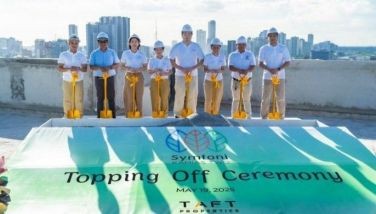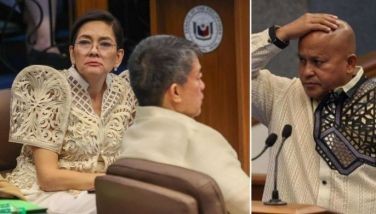N.V.M. Gonzalez: A writing life

The round, silver-haired man in front of me spoked easily and with eloquence. His eyes crinkled with laughter as he traced the parabola of a life lived in the last 80 years.
I was with National Artist N.V.M. Gonzalez at the Philippine Book Fair one September afternoon many years ago. He just launched his 13th book, Work on the Mountain, from the University of the Philippines Press. He was at work on his next book. N.V.M. Gonzalez still woke up at down to write, when the rest of us were just going home from a night out, or still crumpling our tired bodies on our beds.
Nestor Vicente Madali Gonzalez was born in Romblon, Romblon, on Sept. 8, 1915. He used to sign his name either as Nestor Gonzalez or Nestor V. Gonzalez. “But in the mid-1930s, my mother suggested, why don’t you just use your full name? So I just wrote it like that.”
His father was a school supervisor and his mother, a teacher. When he was four, his family moved to Oriental Mindoro – a wilderness at that time, land of migrants and hard survivors. They settled in Wasig, a barrio bordered by a mangrove forest and a river. His father set up a homestead in a village called Barok, clearing the land to grow abaca, coconuts and coffee. Some of the proud, pioneering spirit, the respect and familiarity with the land and the people who work it, is evident in his fiction.
He graduated from Mindoro High School at 15, but did not attend college immediately after. For two years, he helped his father in Wasig, on the homestead in Barok, and the slaughterhouse and meat stall in Calapan. He called those years as his “apprenticeship.” He was inadvertently living the life I was later to describe – “talking to people, finding my way around, committing to memory every turn of the road, every bush by the wayside.”
At 18, he began thinking seriously of going to the university. But he said, “The trouble was that it seemed college was not exactly the route for me. For some reasons I could not explain, I wanted to be a writer. And in the Philippines at that time, the best writers had been self-taught.”
He continued: “One day, I had nothing to do so I pulled out a book in the library. It was called ‘Styles’ by Robert Louis Stevenson. It was a very thin book, around 120 pages. And you won’t believe this, and I don’t believe this myself, but I copied that book word for word on a typewriter. That’s how I learned to punctuate, how to put semicolons, how to put a dash. And of course, I had this feeling that Robert Louis Stevenson’s style rubbed off on me a little. That was my illusion.”
He laughed soundlessly, the mirth lighting up his face. “But doing that was not enough, since I had wanted to possess the book. So I started by folding a coupon bond twice over, then typing on both sides. I bound the book in my own fashion using cloth. I don’t know where is the book now, but that was my first instruction in writing.”
After that, he began to write in earnest. He started with short stories, which he submitted to the Graphic magazine. He would leave his home in Wasig at five in the morning and walk to the town of Mansalay, reaching it at ten o’ clock. He would type his stories in the town hall, post the manuscript, then return home. However, his stories were rejected and the manuscripts returned, but always with an encouraging note from the editor.
N.V.M. Gonzalez finally went to Manila in 1933. From the eyes of a boy from the province, the literary scene looked forbidding. “The writers who are considered to have arrived included Manuel C. Arguilla, Paz Latorena and Federico Mangahas. One of my friends was Franz Arcellana, whose father worked in a lighthouse. He was the first person I contacted in Manila after I arrived from Mindoro.”
Mr. Gonzalez attended two years of university studies, and then he dropped out. He continued writing his short stories. Soon, they began appearing in the Philippine Magazine. Twelve of the early stories were later included in his first book, “Seven Hills Away.”
They say that if you wrote a good book, it was like a passport: it would open doors for you. And that was what happened to N.V.M. Gonzalez with his first book.
“Someone at the Rockefeller Foundation must have read my book early in 1947 when it came out because one day – I was then working at the Evening News Saturday Magazine – I received a telephone call. It was from Charles Fahs, head of the Humanities Program at the Rockefeller, and he wanted to meet me. He asked me to recommend writers for a fellowship, so I gave him names. Later, I got another call from him, asking if I might be interested in going to the United States to study writing.”
But I had an aversion to going to formal studies at the university. “So they told me that I could go anywhere I liked, but I wasn’t sure I wanted to study under one program, or take course work. So I said, ‘Let me draw up my own schedule of programs.’ I wanted to study and meet certain writers and professors all over the US. They included Edward Muir, Katherine Anne Porter, Herbert Read of Kenyon College, Mark Schorer, Wallace Stegner of the Stanford University’s Writing Center and Yvor Winters.”
Rockefeller agreed and gave him the fellowship. “When our ship arrived in San Francisco, there was a strike so we could not land. It had to dock in Oakland. In my story, ‘Crossing Over,’ I described nearly how it was. The point of the story was there was this young fellowship student who arrived in America completely unprepared, mentally and financially.”
But N.V.M. Gonzalez had arrived, and the second phase of his writing life had begun.
* * *
Danton Remoto’s novel, “Riverrun,” was published by Penguin Books to critical acclaim. Copies are available at www.acrephils.com and Amazon.
Email: danton.lodestar@gmail.com
- Latest
- Trending

































